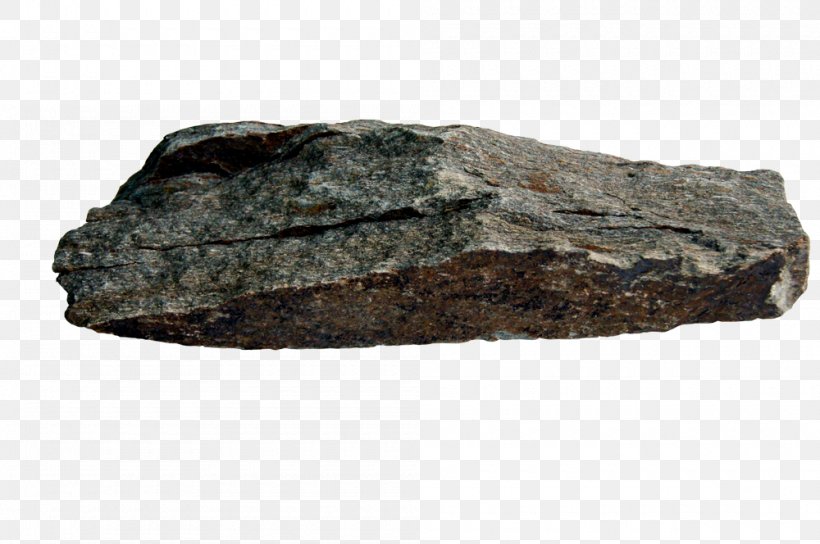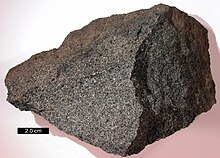Igneous

Igneous rock is one of the three main rock types, the others being sedimentary and metamorphic rock.
Igneous rocks (from the Greek word for fire) form when hot, molten rock crystallizes and solidifies. The melt originates deep within the Earth near active plate boundaries or hot spots, then rises toward the surface. Igneous rocks are divided into two groups, intrusive or extrusive, depending upon where the molten rock solidifies.
Igneous rocks are rocks formed from molten magma. The material is made liquid by the heat inside the Earth's mantle.
When magma comes out onto the surface of the Earth, it is called lava. Lava cools down to form rocks such as tuff and basalt. Intrusive rocks are made when the magma slowly cools to form rocks under the surface. Granite is one of these.
Geological significance[changechange source]
The upper 16 km (10 miles) of the Earth's crust is composed of about 95% igneous rocks with only a thin, widespread covering of sedimentary and metamorphic rocks.[1]

Igneous rocks are geologically important because:
- their absolute ages may be got from various forms of radiometric dating. This gives information about the dating of adjacent non-igneous geological strata;
- their features are usually characteristic of a specific tectonic environment (see plate tectonics);
- in some special circumstances they host important mineral deposits (ores): for example, tungsten, tin, and uranium are commonly associated with granites and diorites, whereas ores of chromium and platinum are commonly associated with gabbros.
Two types[changechange source]
Igneous rock occurs in two ways.
- Igneous rock formed from magma that has become solid inside the earth is called intrusive igneous rock. Examples of intrusive igneous rock types are gabbro, diorite, and granite.
- Igneous rock formed from lava that has become solid on the outside of the Earth is called extrusive igneous rock. This can happen because of the eruption of a volcano. Some extrusive igneous rock types are basalt, andesite, rhyolite, tuff, obsidian, and pumice.
Magma[changechange source]
Magma is a complex high-temperature fluid substance. Temperatures of most magmas are in the range 700 °C to 1300 °C. Magma can get forced into adjacent rocks (intrusion or plutonic), or forced out to the surface (extrusion or volcanic) as lava, or blown out in exposions which include rock pieces (tephra).
Magma is made up of atoms and molecules of melted minerals. When magma cools the atoms and molecules rearrange to form mineral grains. Rock forms when mineral grains (often crystals) grow together. Granite, diorite, gabbro and basalt are a few types of igneous rock. Quartz is one of the chief minerals produced by igneous action; it is made of silica (SiO2), the most common molecule in igneous minerals. Some examples of igneous volcanic rock are pumice, obsidian (volcanic glass), and scoria and much more.
Minerals[changechange source]
Most of the minerals that make up igneous rock are of these types:[2]p12
- Feldspars & feldspathoids
Chemical make-up[changechange source]
Igneous rocks can be classified according to their chemistry. The main types are:
- Mafic: a silicatemineral or igneous rock which is rich in magnesium and iron.
- Felsic: silicate minerals, magma, and igneous rocks which are rich in the lighter elements such as silicon, oxygen, aluminium, sodium, and potassium.
The first six minerals in the list are silicates. Oxides are mostly of iron.
Related pages[changechange source]
References[changechange source]
- ↑Klein, Cornelis and Cornelius S. Hurlbut, Jr. 1985. Manual of mineralogy, Wiley, 20th ed, p275 ISBN0-471-80580-7
- ↑Smith P. 1900. Volcanoes: a planetary perspective. Oxford.
Molten lava cooling and forming igneous rock at Hawai'i Volcanoes National Park, Hawai'i. NPS photo by Janice Wei. Extrusive Igneous RockExtrusive, or volcanic, igneous rock is produced when magma exits and cools as lava at or near the Earth's surface. Exposed to the relatively cool temperatures of the atmosphere, the lava cools quickly meaning that mineral crystals don't have much time to grow. This results in rocks with a very fine-grained or even glassy texture. Hot gasses are often trapped in the quenched lava, forming bubbles (vesicles).
Types of extrusive igneous rocks include: pumice, obsidian, andesite, rhyolite, and basalt. Volcanic processes has shaped the extrusive igneous rock formations at these parks:.Hawai'i Volcanoes National Park, Hawai'i.Sunset Crater Volcano National Monument, Arizona.Crater Lake National Park, Oregon Also see. Dark colored diabase dikes intrude through light colored granite at Acadia National Park, Maine. NPS photo by Georgia Hybels.
Pariah fish. Nattereri, and P. Historically, however, other classifications have expanded the group to include four genera: Pristobrycon, Pygocentrus, Pygopristis, and Serrasalmus, based largely on the single row of sharp triangular teeth all members display.
Intrusive Igneous RockIntrusive, or plutonic, igneous rock forms when magma remains inside the Earth's crust where it cools and solidifies in chambers within pre-existing rock. The magma cools very slowly over many thousands or millions of years until is solidifies. Slow cooling means the individual mineral grains have a very long time to grow, forming a rock with large, visible crystals. National parks with excellent examples of intrusive igneous rocks include:. Acadia National Park, Maine. Joshua Tree National Park, California. Yosemite National Park, California Also see.